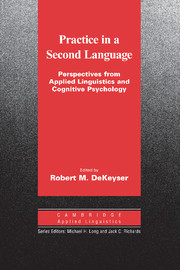Book contents
- Frontmatter
- Contents
- List of contributors
- Series editors' preface
- Introduction: Situating the concept of practice
- I: FOUNDATIONS
- Chapter 1 Input in the L2 classroom: An attentional perspective on receptive practice
- Chapter 2 Output practice in the L2 classroom
- Chapter 3 Interaction as practice
- Chapter 4 Feedback in L2 learning: Responding to errors during practice
- II: INSTITUTIONAL CONTEXTS
- III: INDIVIDUAL DIFFERENCES
- Conclusion: The future of practice
- Glossary
- Index
- References
Chapter 1 - Input in the L2 classroom: An attentional perspective on receptive practice
Published online by Cambridge University Press: 27 January 2010
- Frontmatter
- Contents
- List of contributors
- Series editors' preface
- Introduction: Situating the concept of practice
- I: FOUNDATIONS
- Chapter 1 Input in the L2 classroom: An attentional perspective on receptive practice
- Chapter 2 Output practice in the L2 classroom
- Chapter 3 Interaction as practice
- Chapter 4 Feedback in L2 learning: Responding to errors during practice
- II: INSTITUTIONAL CONTEXTS
- III: INDIVIDUAL DIFFERENCES
- Conclusion: The future of practice
- Glossary
- Index
- References
Summary
Introduction
The role of input is undoubtedly crucial in the process of second/foreign language (L2) learning. Input may be defined as the L2 data (form-based and/or meaning-based) that learners receive either in the formal classroom or in a naturalistic setting. Indeed, how L2 input is presented to L2 learners in the classroom and its effects on the processes learners employ to interact with the input (input processing) have been the focus of several strands of second language acquisition (SLA) studies conducted within a psycholinguistic framework. The theoretical underpinnings of most of these psycholinguistic studies appear to include some role for attention (and possibly awareness) in the processing of L2 grammatical or linguistic data in adult learners' L2 development (e.g., Robinson, 1995; Schmidt, 1990, 1993, 1995, 2001; Tomlin & Villa, 1994; VanPatten, 2004).
The term practice has several connotations (see DeKeyser, this volume for an elaborated discussion of this term in several fields of inquiry) in both the applied linguistics and cognitive psychology literatures. In applied linguistics, the notion of pedagogical practice in the typical classroom assumes some form of performance by learners in response to L2 grammatical input they receive in this setting, which may be provided prior to or during practice. In addition, the L2 input is usually manipulated in some form by the teacher. For example, learners may be exposed to L2 that has been carefully selected and manipulated by the teacher to highlight some linguistic data and may be requested to interact with it in several ways, such as selecting options related to the linguistic data in the input, performing a task, and so forth.
- Type
- Chapter
- Information
- Practice in a Second LanguagePerspectives from Applied Linguistics and Cognitive Psychology, pp. 21 - 50Publisher: Cambridge University PressPrint publication year: 2007
References
- 15
- Cited by



